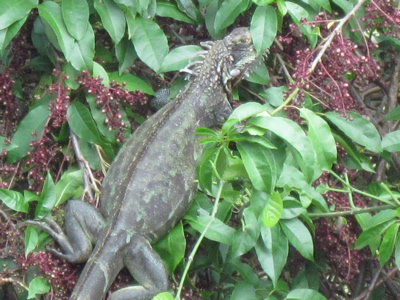
It’s particularly apparent on St. John, where more than half the island’s land is undeveloped thanks to the presence of the Virgin Islands National Park. This gives deer and iguanas plenty of room to roam and dine on whatever catches their fancy.
The deer and iguanas are everywhere, including locations that never before saw them.
“Growing up, I heard about deer but I never saw them. Now I see three, four, five a week,” said Rafe Boulon, chief of resource management at V.I. National Park.
Boulon grew up on St. John and still lives there. He recently saw a herd of nine deer at Caneel Bay Resort.
“There was a whole group of deer cavorting – leaping and running,” he said.
The herd also includes babies, and two were recently spotted with a doe on Caneel Bay’s front lawn.
As for the iguanas, it’s hard to avoid them. One brave one hustled through the crowd in Cruz Bay Park at the June 5 Panorama, nimbly avoiding dancing feet and other hazards. One watched Sunday’s Food Fair from a tree in Cruz Bay Park. On Friday, a visitor to an online travel forum posted photos of several iguanas taking a swim at a St. John vacation villa pool. The visitor also discussed at length how the iguanas used the pool and its environs to “poop.”
According to Boulon, a drop in the mongoose population from a virus about 10 years ago reduced the number dining on baby iguanas. The population of another predator, cats, is also down thanks to a spay and neuter program by the Animal Care Center of St. John.
However, Boulon said the mongoose population is now on the increase, so its impact on the iguana population remains to be seen.
The park’s program to get rid of rats, cats and mongoose had no impact on St. John’s iguana population because the work only occurred at turtle nesting beaches and at Cinnamon Bay and Trunk Bay beaches, Boulon said. The park worked to get rid of rats, cats and mongoose from Cinnamon and Trunk because they get large numbers of human visitors.
On St. Croix, Zandy-Hillis Starr, who is the chief of resource management at all three national park facilities on St. Croix, said it looks to her like the deer and the iguanas are increasing.
In addition to increased rainfall during the last decade, she also cited recovery from the spate of hurricanes that hit the territory in the mid-to-late 1990s.
The jury is still out on the situation on St. Thomas. Judy Pierce, chief of wildlife at the Planning and Natural Resources Fish and Wildlife Division, said it was hard to tell whether the deer are on the increase because the island is so developed, leaving the deer little room to roam. Areas previously undeveloped, like Botany Bay, are seeing a decrease in wildlife habitat as building increases.
“Botany Bay is slowly becoming chopped up,” she said.
Renata Platenberg, a wildlife biologist at the Fish and Wildlife Division, said she’s seen a lot more deer on St. Thomas than previously. And they’re getting more used to humans.
“I see deer standing in the road at Cabrita point,” she said.
Platenberg doesn’t think the iguana population on St. Thomas is growing. Rather, people recently saw lots of dead ones in the road because it was breeding season.
“They’re heavy with eggs. They go to the road to warm up. They don’t get out of the way and they get run over,” she said.
The iguanas on St. Thomas are also used to human interaction because they’re fed by hotel guests, Platenberg said.
“And they’re not chased by dogs and cats and there’s lots of yummy food to eat,” Platenberg said.





